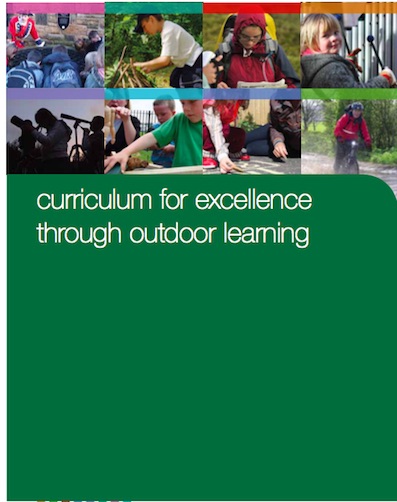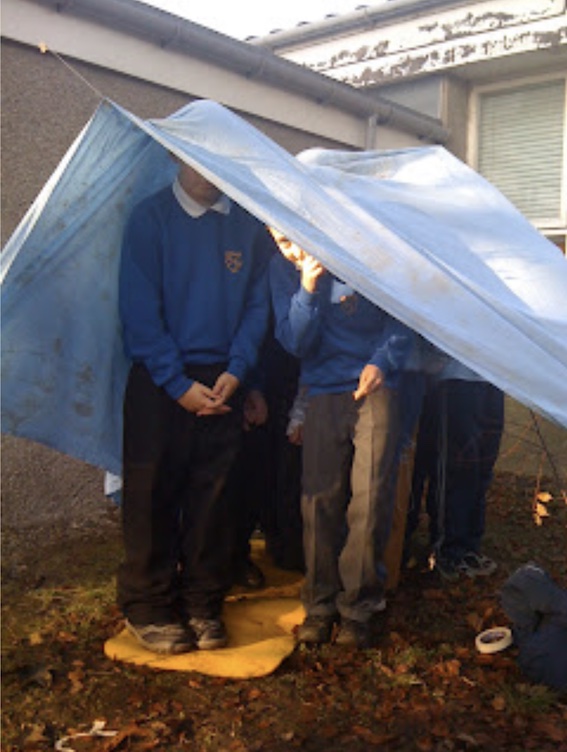In April 2010, the Government published the document, Curriculum for Excellence Through Outdoor Learning. A copy went to every school and Early Learning and Childcare setting in Scotland. Over a decade on, and it remains fit for purpose and schools and ELC settings need to take account of its guidance.
Perhaps the biggest change has been the inclusion of outdoor learning within the Learning for Sustainability umbrella. This has added impetus as the research suggests that outdoor learning is essential to developing the values and actions associated with sustainable lifestyles – you can’t effectively embed LfS without developing your outdoor provision. Also, the GTCS Professional Standards are underpinned by Learning for Sustainability as one of their cross-cutting themes.

The Education Scotland Outdoor Learning website has been continually updated to complement and extend the advice and expectations outlined in the document. It combines information on the health and safety aspects of taking children outside, with a range of resources including self-evaluation advice, relevant research, case studies, lesson ideas and guidance on which experiences and outcomes require an element of outdoor learning.
There are a number of implications for schools and pre-school establishments. Whilst HMIe currently comment on good outdoor learning practice where it is observed, their approach is becoming more rigorous as they pick up on the key themes and expectations outlined in the document.Education Scotland (2022) Successful Approaches to Learning Outdoors is a positive document that looks at schools and ELCs with inspections where outdoor learning was a positive contributor to an inspection.

As with all aspects of education, schools are at different places when it comes to developing their outdoor practice. Here’s some tips and advice to smooth the way outside, based upon the advice in the CfEtOL document.:
First, outdoor learning can be linked to every initiative and all curriculum areas. It may also lead to school improvement very effectively in its own right. But, it could make better sense to include reference to it in developments such as literacy, health and wellbeing, family learning, additional support, Eco Schools, etc. So, don’t make outdoor learning special, include it as part of your “toolbox” of learning and teaching approaches. Likewise adventure and residential activities can be linked to Curriculum for Excellence. What is also important to remember is that the outdoors is a place. Thus making the most of the place where learning is happening can be an important indicator (but not always) of quality.
Schools need to demonstrate that they are providing progressive, sustainable, frequent, regular outdoor learning opportunities. These need to be planned and integrated into ongoing work across all curriculum areas. Giving yourself extra time to build outdoor learning into your forward planning will help. There are some resources on the Education Scotland outdoor learning website. Be aware that there is no expectation to produce an outdoor learning or play policy. Neither should there be an “outdoor skills progression”. This have never been stipulated. It is also important to remember that the terms “outdoor learning” and “learning outdoors” can be used interchangeably. Have a look at the evidence for this, in this blog post.
At the Early Stages, the expectation is that daily outdoor activities will take place all year round, covering all experiences and outcomes. Equal consideration should be given to the indoor and outdoor play opportunities. A simple way to ensure this begins to happen is for planning formats to be altered to reflect indoor and outdoor opportunities equally to ensure that a comprehensive range of outdoor experiences are offered to children. This blog post, Valuing the Outdoors, is a lovely example of simple changes to routines that can make a difference.
All staff are expected to play a part in enabling children to make the most of the outdoors. It is not just the role of teachers. Thus consideration of free play outdoors at break times, opportunities for having lunch outside and outdoor activities provided after school are part of the wider considerations.
Developing partnerships with outdoor organisations and professionals is encouraged. However it is expected that class teachers to be undertaking the bulk of the outdoor learning activities as part of their planned approach to engaging learners and developing wider achievements. The partnerships should provide continuing professional development and to enable school staff to deliver outdoor learning independently as much as possible.
One approach that works well is to arrange for an outdoor professional to lead a class lesson supported by the class teacher. The following week, the roles are reversed and the outdoor professional supports the teacher to undertake a lesson outside and to plan a series of outdoor activities throughout the rest of the term that the teacher can deliver independently. Shared planning sessions with several teachers bouncing ideas off each other helps, especially when planning outdoor activities for projects which have less obvious outdoor links (they are still there though)!

Den building being used as part of a Global Citizenship project
There is a clear focus on school grounds and local area as a context for outdoor learning rather than visits to places further afield where there are cost implications. Repeated visits or use of local amenities is strongly encouraged both in CfEtOL and through many experiences and outcomes, particularly within social studies. This helps children develop a sense of place and belonging as well as getting to know people and businesses in the local community.
There are many outdoor activities that can be undertaken on grass and tarmac. Do not rush to purchase expensive outdoor “classrooms” or other structures. Instead, spend your money on a subscription to the school grounds charity Learning through Landscapes and a site visit from one of their accredited school grounds professionals. Taking a planned, sustained, participative approach to developing your outdoor area in a way that meaningfully involves the children is empowering for everyone involved. Furthermore, many school grounds improvements can be undertaken on a shoestring budget using locally sourced, recycled or donated materials and plants.
For some teachers, taking children outside on a frequent, regular basis may prove challenging. Just like other changes, time is needed to develop routines and establish the habit. Health and safety is frequently cited as a concern. Risk benefit assessments can play a part in enabling outdoor activities to be as safe as necessary. There are many ways of involving children of all ages in this process.
In our rapidly changing society, where children have increasingly indoor, sedentary lifestyles there is a greater need, more than ever before, for children to experience the world beyond the four walls of the classroom or house. So now is the time to get children outdoors and enjoy the social, cognitive and health benefits that this will bring alongside the satisfaction of “making a difference” to children’s lives now and in a more sustainable future.
This blog post was originally written in May 2010.




















What a difference between your government’s approach to education and ours. Even with a more progressive government, we still seem hell-bent on standardized testing and more time in the classroom. I’m so happy I’m not a public school teacher these days so I’m free to educate the whole kid and not just from the neck up, with a strong emphasis to one side of the brain.
That is a wonderful quote Tom! Our education is founded on principles that are sound but there’s that push-pull between this and the need for attainment data that “proves” our teachers are successfully educating our children.
However it’s still possible to “do your thing” within mainstream education system providing you can demonstrate that everyone’s on board and it’s making a positive difference.